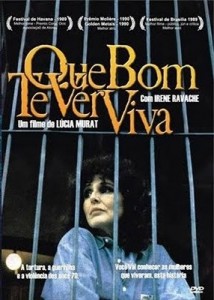
 Director: Lúcia Murat
Director: Lúcia Murat
Writer: Lúcia Murat
Actor(s): Irene Ravache
Production Co.: Casablanca Filmes
Country: Brazil
Year: 1989
Language and subtitle information: Portuguese, with optional subtitles in English and Spanish
Format: DVD
[ratings]
Summary: Film about the torture of women under the military dictatorship in Brazil in the 1970s. Part documentary, and part drama, the main character also serves as narrator.
Supplemental Materials:
This film is a quasi-documentary about the torture of women during the military dictatorship. Narrated by the “protagonist”, the spectator is taken through narratives of a few different women who were tortured. The way in which this torture affected the women was different in each memory, but there was clearly a tie between torture, power, and the humanity of both the oppressed and the oppressor. Both the choice of music and the dramatization took away from the power of the piece, but the information the spectator learns is invaluable and serves as another lens through which he or she can learn about the effects of the dictatorship, especially in relation to power.
“Que bom te ver viva” is a documentary of sorts that explores some of the torture that went on during the Brazilian military dictatorship in the 60s, 70s and early 80s. The documentary consists of a series of interviews of women that were imprisoned and tortured by the government during this time. Interestingly, this film focuses on women and only women – the first of this kind I’ve seen. The relationship between power and eroticism was well-evident in their testimonies. Sexual torture was common and a woman’s power over her own body was stripped my the military men empowered by the corrupt government that gave them freedom to do whatever they wanted with no questions asked, as long as subversives and “communists” were taken care of. Although, I do feel that some of the effects including the music and still-frames with personal bios of individual women were over the top at times and perhaps took away from some of the impact and ethos of the stories, I learned a lot about the military dictatorship and its disciplinary tactics from this film. I was also to see much more clearly the relationship between power and eroticism.
The film is a documentary of sorts. It starts off with a dramatized monologue that explores themes of power, survival, and the complexities involved in the preservation of the human spirit – written by Lúcia Murat, that is performed by an actress. Additionally, various women recount their experiences of torture under the military dictatorship and how they overcame that trauma or continue to live with those experiences. While the testimonies of the women are striking, the dramatized monologue and eerie music take away from the film. I felt that there was a disconnect between the protagonist’s performance piece and the women’s accounts. However, overall, the film is an incredible opportunity to hear first-hand survival stories from women who served as part of the vanguard of change during those years of repression.
“Que Bom te Ver Viva” is a film that integrates scenes of actor portrayal and real interviews to tell the stories of women tortured during the Brazilian military dictatorship. While the choice to recount the story of female torture using acting and true accounts is unique, the actress’ performance interwoven between interview clips takes away from the power of such footage. However, the raw emotions of the women interviewed as well as the lasting impacts of torture are clearly conveyed to the viewer. The film succeeds in representing the reality of the impacts of torture while still highlighting strength through survival.
Ver Viva” was created by Lúcia Murat, a torture survivor herself.